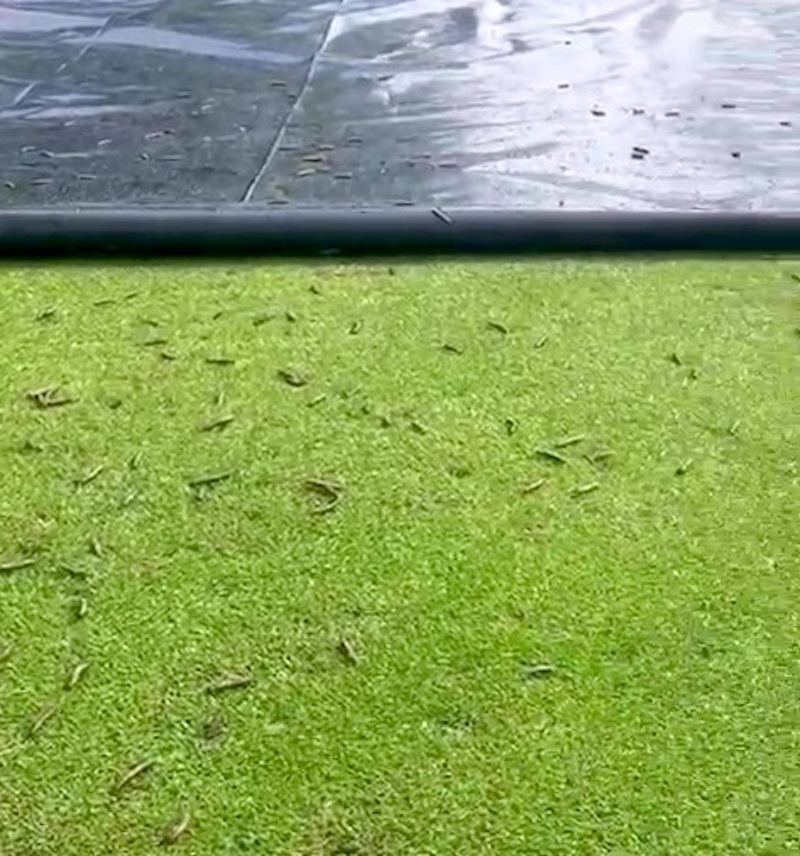What Are Leatherjackets And Why Are They A Problem For Golf?
You might not have heard of Leatherjackets, but they cause issues for greenkeepers and have a huge impact on the maintenance of golf courses...


You might have overheard conversations between greenkeepers and club staff about the problems caused by this invasive species at your local club. Leatherjackets are the the larvae of the crane fly or daddy longlegs, and typically hatch around August or September. The creatures are quick-breeding and have a very short life-span, but can still cause untold damage to the golf course.
In this article, we explore their impact further and discuss how to support your green staff with managing the problem...

How do Leatherjackets affect the golf course?
Upon hatching, Leatherjackets are immediately on the wing with their sole purpose to find a mate. They deposit their eggs into the ground, resulting in the grubs or larvae feeding on the grass until pupating and eventually re-emerging.
The issues arises during the period when the larvae are in the ground, as they feed on grass roots during the day and surface on damp evenings to feed on leaf tissue. The up and down movement out of the soil can leave a pitted and often bumpy surface, especially on putting greens.

That isn't the only concern, however, as Leatherjackets are also a desirable snack for birds and other foraging animals. As the predators know that the Leatherjackets lurk not far beneath the surface, they set about to retrieve them causing damage to the course.
While some birds, like crows, will peck the Leatherjackets out from the ground, some larger creatures, such as badgers, cause a much more significant level of damage.

Why is it more of a problem now for golfers than before?
There are two main reasons, according to Paul Woodham, general manager of agronomy at STRI (Sports Turf Research Institute).
Get the Golf Monthly Newsletter
Subscribe to the Golf Monthly newsletter to stay up to date with all the latest tour news, equipment news, reviews, head-to-heads and buyer’s guides from our team of experienced experts.
“With climate change etc, we don’t seem to get the very cold winters that kill these bugs, so we’re seeing higher populations. And, critically for sports turf and golf, the insecticide that was previously used at low cost to treat these things (Chlorpyrifos) was taken off the market in 2016, and for good reason, because of its damage to the environment.
“There is now only one preventative insecticide. But it can only be used with emergency approval so it’s not widely available and is not as effective as the old one.”
🐛 Living with Leatherjackets...Working alongside experts from @RandA's Sustainable Agronomy Service, we're delighted to bring you a series of informative features on the challenges faced and how we can all help... 🤝@GolfMonthly#TheSustainabilityDrive pic.twitter.com/IctjL89CEwMay 10, 2024
One of the main reasons for the withdrawal of Chlorpyrifos was that it is harmful to pollinators. There is rightly now a real desire to help and promote pollinators rather than do anything to cause them harm.
“In a recent survey,” Woodham continues, “while disease, particularly common winter diseases, are still the No.1 concern [for greenkeepers], how we deal with pests and certainly leatherjackets is quickly catching up as the cause for greatest concern.”
Managing expectations
So, what can be done to negate the issue?
At the moment, precious little, although some clubs are reporting success by putting sheeting over areas to draw the grubs up and collecting them for disposal. But that can be labour-intensive and isn’t guaranteed to remove all leatherjackets in a given area.

Final word goes to Woodham: “We need to investigate more non-chemical strategies, but more than that, we need to educate the golfers that this is the reality – that it’s not as simple as the old chemicals.
“Gone are those days and rightly so, but it’s hard with golfer expectations getting higher and higher. We have to accept that things may not always be as pristine as we’ve been used to. These areas will recover, but it takes patience and commitment.”

What can golfers do to help?
Firstly, exercising a little patience will go a long way. Perhaps, before mentally drafting a letter of complaint about your dismay with current course conditions, consider the work that the greens staff and the club are doing to manage the problem. You could even ask if there is anything you can do to help!

Jeremy Ellwood has worked in the golf industry since 1993 and for Golf Monthly since 2002 when he started out as equipment editor. He is now a freelance journalist writing mainly for Golf Monthly. He is an expert on the Rules of Golf having qualified through an R&A course to become a golf referee. He is a senior panelist for Golf Monthly's Top 100 UK & Ireland Course Rankings and has played all of the Top 100 plus 91 of the Next 100, making him well-qualified when it comes to assessing and comparing our premier golf courses. He has now played 1,000 golf courses worldwide in 35 countries, from the humblest of nine-holers in the Scottish Highlands to the very grandest of international golf resorts. He reached the 1,000 mark on his 60th birthday in October 2023 on Vale do Lobo's Ocean course. Put him on a links course anywhere and he will be blissfully content.
Jezz can be contacted via Twitter - @JezzEllwoodGolf
Jeremy is currently playing...
Driver: Ping G425 LST 10.5˚ (draw setting), Mitsubishi Tensei AV Orange 55 S shaft
3 wood: Srixon ZX, EvenFlow Riptide 6.0 S 50g shaft
Hybrid: Ping G425 17˚, Mitsubishi Tensei CK Pro Orange 80 S shaft
Irons 3- to 8-iron: Ping i525, True Temper Dynamic Gold 105 R300 shafts
Irons 9-iron and PW: Honma TWorld TW747Vx, Nippon NS Pro regular shaft
Wedges: Ping Glide 4.0 50˚ and 54˚, 12˚ bounce, True Temper Dynamic Gold 105 R300 shafts
Putter: Kramski HPP 325
Ball: Any premium ball I can find in a charity shop or similar (or out on the course!)
-
 What Golf Shoes Is Justin Rose Wearing At The Masters?
What Golf Shoes Is Justin Rose Wearing At The Masters?The Englishman has been seen wearing a number of shoes throughout his career and, at the start of 2025, Rose has been spotted donning footwear from PAYNTR Golf
By Matt Cradock Published
-
 I Am So Fed Up With The Masters Television Coverage... Why Can't We Watch A Full Day's Play?
I Am So Fed Up With The Masters Television Coverage... Why Can't We Watch A Full Day's Play?The strict television rules around The Masters at Augusta National are really starting to bug me, especially in this modern era of mass sports consumption...
By Barry Plummer Published
-
 7 Most Annoying Golf Playing Partners
7 Most Annoying Golf Playing PartnersWe showcase the seven most annoying playing partners that golfers can have the misfortune of teeing it up with!
By Sam Tremlett Published
-
 How To Clean Golf Clubs And Grips
How To Clean Golf Clubs And GripsIf you want to know how to clean golf clubs and grips, check out this step-by-step guide
By Sam Tremlett Published
-
 In Praise Of Golfing In Winter
In Praise Of Golfing In WinterFergus Bisset on why he enjoys playing golf through the winter months
By Fergus Bisset Published
-
 'Why Do Golfers Only Wear One Glove?' You Asked Google And We've Got The Answer...
'Why Do Golfers Only Wear One Glove?' You Asked Google And We've Got The Answer...You asked Google and we've got the answer...
By Roderick Easdale Published
-
 How To Regrip Golf Clubs
How To Regrip Golf ClubsKnowing how to regrip golf clubs means you can afford to replace them as and when they need replacing
By Joe Ferguson Published
-
 The 7 Scariest Shots in Golf
The 7 Scariest Shots in GolfWith Halloween creeping up, we have selected the 7 scariest shots in golf
By Neil Tappin Published
-
 17 Ways To Tell You're Obsessed With Golf
17 Ways To Tell You're Obsessed With GolfThe tell-tale signs that you are a true golf fanatic
By Roderick Easdale Published
-
 10 Of The Best Arnold Palmer Quotes
10 Of The Best Arnold Palmer QuotesHere we take a look at 10 of our favourite Arnold Palmer quotes
By Roderick Easdale Published